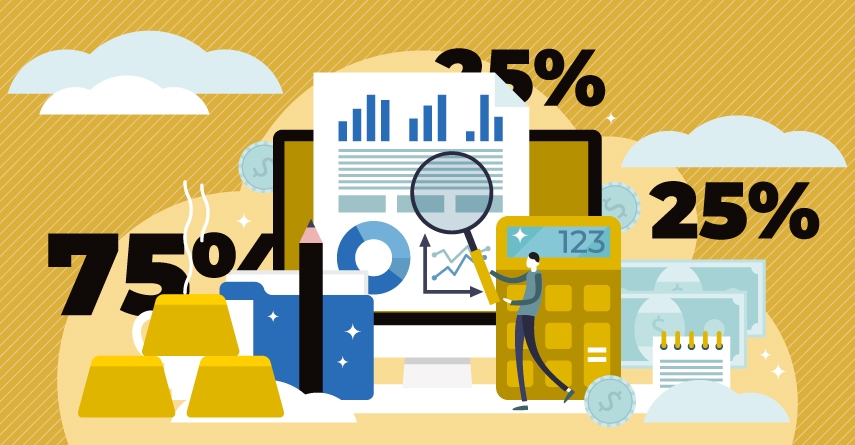
Chapter 6: Diversifying Your Portfolio: How to Start a Precious Metals IRA
Some investors may worry about economic inflation or market volatility affecting the value of their assets and whether or not there are other options for investing. Thankfully, there are a number of ways to diversify your investment portfolio.
If you’re the owner of an individual retirement account (IRA) and have wondered about how a precious metals IRA works, or have gold IRA considerations, now may be a good time to learn about the advantages of alternative investment options like a precious metals IRA.
Precious metals IRAs may prove to be a solid investment vehicle in the ever-changing markets because they are backed by physical assets. Including IRS-approved precious metals in your account may help secure and grow your investments.
But if you’ve never invested in precious metals before, the process may seem confusing. We’re here to break down all the details of what a precious metals IRA is, how to start a precious metals IRA, and what types of precious metals are approved for investment.
What Is a Precious Metals IRA
A precious metals IRA (individual retirement account) is a type of self-directed IRA that allows investors to direct retirement funds towards alternative investments like:
- Real estate
- Bonds
- Private companies
- Precious metals (gold, silver, platinum, palladium)
Investors can contribute to a new account or roll over a portion of their current retirement accounts (gold 401(k) rollover) to diversify their portfolio. A precious metals IRA can also protect against a weakening US dollar. Since recessions are cyclical, there really isn’t a bad time to consider precious metals like gold as an investment.
Precious metals IRAs, and gold IRA investing in particular, is a great option if you’re looking to invest in precious metals. Seen as the most popular of precious metals, gold doesn’t corrode and is malleable and conductive, which makes it highly desirable for many uses. It’s also frequently used for jewelry and electronics and the demand for gold may contribute to an increase in daily gold prices over time.
Additional precious metals to consider for investing are:
Silver – Often used in electronics, silver’s thermal and electronic conductivity make it an ideal metal for industrial applications that can’t be substituted with cheaper metals. Silver is used in computers, tablets, cell phones, televisions, automotive parts, solar panels, and more.
Platinum – Primarily used in automotive applications for catalytic converters to help reduce harmful emissions. It’s also used in jewelry and other refining catalysts along with some computer applications. Platinum is rarer than gold or silver and has historically been as expensive as gold.
Palladium – Palladium is 15 times rarer than platinum and 30 times rarer than gold. It’s used in automobile manufacturing, electronics, dentistry, and fuel cell production. Like platinum, palladium is primarily used in automotive catalytic converters.
4 Benefits of Investing in Precious Metals
Before we get into the specifics of how to start a precious metals IRA, here are four key benefits to consider when choosing how to invest:
1. Diversify Beyond the Typical Investments

A diversified portfolio may mean thinking outside the box of investing in stocks and bonds, which is what many financial advisers are most familiar with. By not concentrating your investments in one place, potentially increasing risks, your investments may go further.
When you invest in the traditional mix of stocks, bonds, money market funds, etc., you’re more subject to Wall Street. If financial markets take a downturn, if bond markets become illiquid, if stock markets crash, those traditional assets may perform poorly.
Alternatives like gold IRA investing can leave a portion of your portfolio protected during challenging economic times. Historically, the weaker the stock market, the better precious metals perform, potentially making them ideal assets to protect your portfolio when a recession is on the horizon.
2. Have More Control Over Investments

A self-directed, precious metals IRA may provide investors with more control over their investments. With something like gold as an investment you have more options than a traditional retirement plan like a 401(k), which is limited because it’s employer sponsored.
With precious metals, you may gain more control over your investment portfolio because you are the one who gets to choose which types of precious metals to invest in.
Assets in a precious metals IRA can be transferred easily and sometimes tax-free among your other retirement accounts, too. You can even move some of your precious metals assets back into stocks or bonds as a transfer, if you choose.
3. Potential for Faster Growth

Some precious metals investments, like gold, can have the ability to grow quickly. In fact, gold is the second-best performing asset of the past 20 years, often growing faster than stock markets. But advisers still recommend stocks for asset growth because it can benefit them through fees they charge for stock and bond trades. With a precious metals IRA, you don’t have to pay those fees, which may keep more money in your pocket.
4. Precious Metals IRAs May Offer Tax Advantages

Like a conventional IRA, you can still reap the tax benefits by investing in a precious metals IRA. You can invest with pre-tax dollars, roll over existing retirement assets tax-free, and defer taxation until you decide to take a distribution. Annual contributions to a precious metals IRA can also be tax deductible.
How to Start a Precious Metals IRA
Beginning the process of opening a precious metals IRA is simple, especially when you partner with precious metals experts who know the ins and outs of this type of IRA. While it’s not difficult to start investing in precious metals, you want to make sure you have all the details, like gold-backed IRA information, to adhere to regulations and avoid penalties. Here is our quick guide to getting started with precious metals investing.
1. Select Your IRA Plan
As mentioned above, to invest in precious metals you have to start with a self-directed IRA. As an investor, you can begin a new IRA account, or roll over from an existing retirement account. It’s key to speak with a tax advisor and precious metals expert to make sure that you follow regulations and that any retirement accounts you currently hold are eligible for a gold IRA transfer or rollover, or other precious metals IRA.
2. Select a Precious Metals Custodian
Gold IRA assets need to be stored with a custodian per IRS regulations. Working with precious metals investing experts, like those at ThrustGold, will help you find a custodian experienced with gold IRA investing to make sure your self-directed IRA is set-up correctly.
3. Select Your Precious Metals
When choosing precious metals, it’s important to remember that they need to meet certain IRS rules and regulations to avoid retirement mistakes when investing. Working with a precious metals specialist will ensure that you’re choosing the right types of gold and other precious metals.
4. Purchase Precious Metals
After you choose your desired metals as an investment, you can purchase your gold and work with your custodian to store it. The custodian will keep your assets safe and secure at a bullion depository so that they’re there when you need them.
Now that you’ve learned the basic steps for how to invest in gold and other precious metals, let’s take a look at the details of which precious metals are approved for purchase to ensure you get the most from your investments.
Which Products Are Approved for a Precious Metals IRA?
By choosing approved gold IRA coins and other precious metals products, you can take advantage of the incredible opportunity that precious metals investing offers. While your custodian and precious metals experts can help you make the best decisions about your purchases, it’s helpful to know the rules prior to making any investments.
Investing in Gold Coins That Are IRS-Approved
When learning how to invest in gold, it’s important to understand the rules, which can be found in Section 408(m)(3) of the IRS Code. Here are a few factors to consider:
- Level of fineness for gold IRA coins –.995
- Many collectible coins are not eligible for gold IRA investment, but there are exceptions laid out in the Code. Additionally, here is a list of some IRA-approved gold coins:
- Gold American Eagle
- Gold Buffalo
- Gold Maple Leaf
- Gold Lucky Dragon
- Gold Australian Saltwater Crocodiles
- Royal Mint Gold Lunar Series Coins
- Gold must be held by your custodian until you reach retirement age, at which point you may begin taking distributions. Working with your precious metals IRA provider may be a good way to ensure that you are following IRS rules and regulations.
- Due to IRS regulations, home storage is generally not recommended. While you can purchase gold coins as collectibles, many cannot be counted towards your gold IRA.
- If you already own gold, you cannot add that gold to your IRA, but you can open a gold IRA and purchase new, approved gold.
- IRA contribution limits apply
Additional IRA-Approved Precious Metals
You can also invest in other types of precious metals that meet IRS specifications. Those include silver, platinum, and palladium that meet the following minimum fineness:
- Silver– .999
- Platinum – .9995
- Palladium– .9995
Precious Metals Price Growth
While it may seem hard to believe, the history of gold as a freely-priced metal traded on world markets is relatively short. Sure, gold has been bought and sold around the world for millennia, but for much of that time it was the basis for world currencies, often in a fixed price relationship with silver. Only after gold ceased to back currencies like the US dollar was its price able to shake off government efforts to fix its price.
Until 1900, the US dollar was defined as a specific weight of silver. From 1900 on, the dollar was defined as a specific weight of gold, which worked out to be $20.67 per troy ounce of gold. When FDR nationalized all gold and forbade private ownership of gold, he unilaterally devalued the dollar, with gold being valued thereafter at $35 an ounce.
That $35 per ounce official price lasted until August 15, 1971, when President Nixon closed the gold window, severing the last official link between the dollar and gold. But world gold markets had been taking advantage of arbitrage opportunities before that. All through the 1960s, the London Gold Pool attempted to maintain that price of $35 an ounce, without success. And when Nixon finally threw in the towel, gold was finally able to appreciate freely.
From 1971 onward, the gold price took off. Since that time, gold has performed phenomenally, with average annualized growth of over 8%, higher than price growth of the Dow Jones Industrial Average and the S&P 500. Its performance in the 21st century has been similarly strong, with more than double the rate of growth of stock market indexes. And with growing economic uncertainty and fear of a weak economy for years to come, gold could continue to make strong gains in the future.
Best Practices for Selecting Gold
Purchasing gold and other precious metals is not difficult but doing so responsibly will help you to make the best decisions to reach your financial goals. Here are a few quick tips to remember as you consider gold as an investment:
- Keep investments diverse: Precious metals may help you diversify your portfolio and hedge it against market crashes.
- Understand exchange–traded funds (ETFs): While they may seem convenient, they don’t give you physical ownership of precious metals. Instead, you invest in shares that are at least partially backed by physical gold or other precious metals.
- Ensure precious metals are IRS-approved: No matter which type of precious metals you invest in, it’s vital that they be IRS-approved to qualify for your precious metals IRA.
- Follow contribution limits: Once you’ve established your precious metals IRA, be sure to consult with your custodian and precious metals partners to follow IRS contribution limits.
With the help of precious metals experts like those at ThrustGold, you can be sure that you’re following these best practices and securing your investments for the future. If you’d like to know more about how a precious metals IRA works, about gold IRA rollovers, or additional precious metals investing options, contact ThrustGold today to get started.
Beginner’s Guide
to a Gold IRA
Table of Contents
Chapter 1: Beginner’s Guide to a Gold IRA: Is a Gold IRA a Smart Investment Choice?
Chapter 2: Gold IRA Rules to Know Before Investing
Chapter 3: Tips for Diversifying Your Retirement Portfolio With Gold
Chapter 4: How to Move Your 401(k) to Gold Without Penalty
Chapter 5: How a Self-Directed Gold IRA Works
Chapter 6: Diversifying Your Portfolio: How to Start a Precious Metals IRA

Ready to Protect Your Retirement Savings?
Get our FREE Precious Metals Guide
With this guide, you’ll learn everything there is to know about investing in gold and silver with a precious metals IRA. Whether you’re a long-time precious metals investor or a first-time buyer, our FREE guide will explain the advantages of precious metals IRAs, how to get started investing in precious metals, and how long the IRA process will take.
Request your FREE guide today and learn how you can harness the power of gold and silver to protect your retirement savings.

Ready to Protect Your Retirement Savings?
Get our FREE Precious Metals Guide
With this guide, you’ll learn everything there is to know about investing in gold and silver with a precious metals IRA. Whether you’re a long-time precious metals investor or a first-time buyer, our FREE guide will explain the advantages of precious metals IRAs, how to get started investing in precious metals, and how long the IRA process will take.
Request your FREE guide today and learn how you can harness the power of gold and silver to protect your retirement savings.




